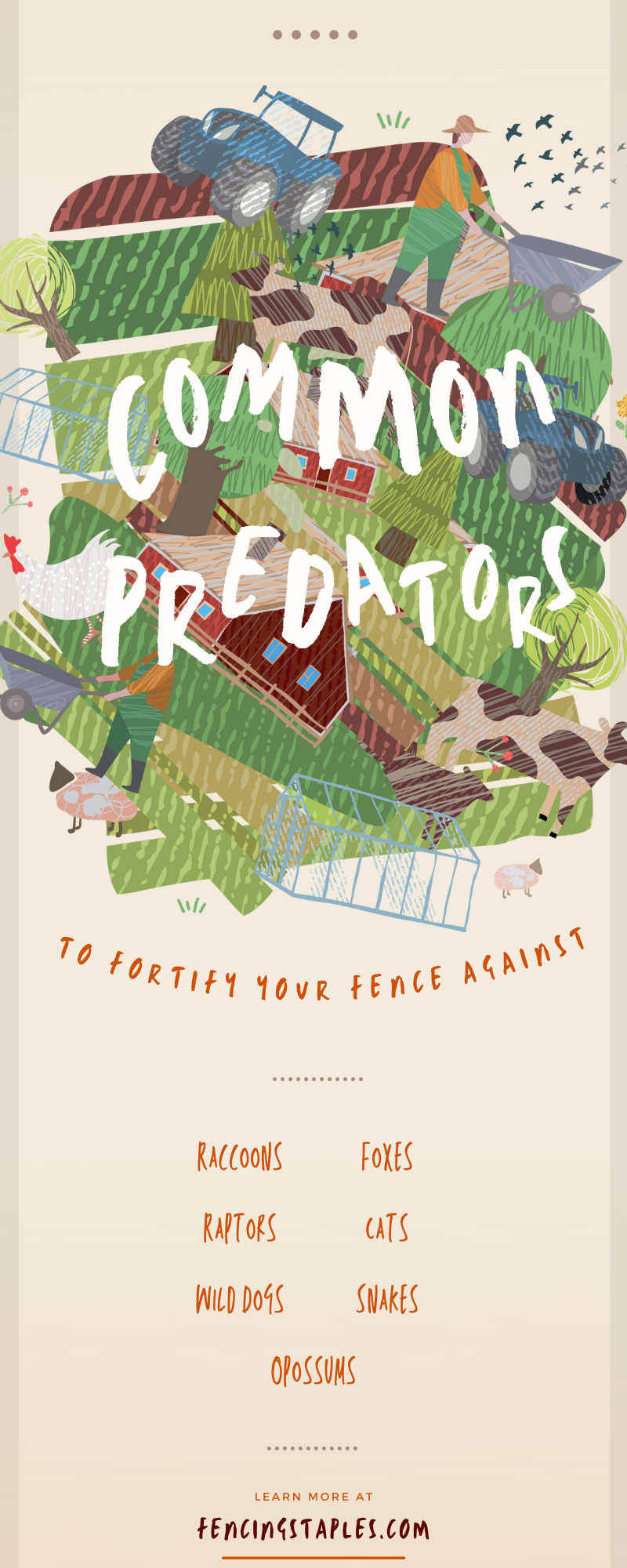Fortify your fence whether you live in a more urban setting or rural, you will need to establish yourself when you move into your home and find out what the natural wildlife looks like where you are at. Every place has different ecosystems, which call for different species that can hunt in those habitats. Once you learn about these ecosystems, you can pinpoint your own ecosystem and discover what could be plaguing you.
Defending your home should be your priority, especially against pests. Look over these common predators to fortify your fence against so that you don’t run into any unnecessary problems moving forward.
These fierce, flying birds of prey are nothing to squawk at. They tend to feast on smaller prey, such as dogs, cats, chickens, and mice, and other wild animals lurking on the ground. What makes these predators so formidable is that they don’t leave any evidence of their hunt. So once something is gone from their kill, you will likely never find it. The prey is out of sight and out of mind. Because there are no traces of evidence, spotting the predator is difficult, if not impossible, especially when it strikes.
You will have to keep your eyes on the skies and study the bird patterns around your general area to learn what is in your geographical location. Then, you may understand what has attacked your pets and livestock if you have any. Hawks are typically one to hunt in the daylight hours, while owls hunt exclusively at nighttime. You might want to think about investing in either a screening of some kind or an overhang, just so the animals will have a place for retreat in the event of another potential attack.
These creatures have some of the most definitive dexterity, allowing them to get into places most others cannot. They are also cunning and have the intelligence to unlock hinges and doors. So make sure you have your fences, gates, and doors secured!
You can spot a raccoon by seeing what a mess he makes. Raccoons are notorious slobs and take their messes with them wherever they go. Now that you know what to look for, you have a better chance of defending your animals against them. You might need to put up some hardware cloth or exchange whatever fencing you currently use for something with a tighter, more enforced weave pattern.
These predators are a real menace if you have them in your region. They can snatch whole chickens and carry them off. Don’t be fooled by their kind appearance. If you’re unsure that it’s a fox, you can check the ground for feathers as foxes have a hard time swallowing them and tend to make a mess if chickens are involved. If you believe that you have a fox problem, installing a motion sensor light is a good way to keep them at arm’s length. Foxes are skittish around people and lights and will run off if they think you’ve spotted them.
Believe it or not, domesticated or undomesticated, one thing that we didn’t breed out of dogs is the ability to hunt. Dogs have a tenacity for seeking things out and hunting either for sport or food. You might find one key trait between a wild and a domesticated dog: a wild dog will carry off the carcass of its prey and consume it, while a domesticated dog will likely leave it. The simplest way to rectify this issue is to fortify your fence by putting up a tall and sturdy fence. If this still doesn’t resolve the problem, you might have to invest in an electric fence.
These predators leave a similar trail to that of the fox, as they can’t swallow feathers. So if you happen to see a trail of feathers, you can be sure it’s either a fox or a cat that you’re after. One distinction that cats have that you can always identify with is their incisor marks alongside the prey’s bones.
If it’s a larger wildcat, like a bobcat or a panther, they will hunt at dusk and dawn and carry the whole animal away once they have made their kill. What makes cats so unique is that no matter the cat’s size, they are always agile and can fit through small spaces easily. You will need to inspect your fencing to make sure there aren’t any holes present and fill them or patch up your problem areas.
These creatures can be hard to find as they spend most of their lives on the ground. They can move quite fast, too, so tracking them is tricky. Another issue that comes with tracking snakes is that they eat their prey whole. So what you can do is keep your eye out for missing animals. This will be an indicator of what could be preying on your land. For these pests, you’ll need to patch up your fencing and compact your soil where the fence meets it so that they have no entry.
These predators are otherwise known as “nest stealers” and have a reputation for leaving with an entire nest in hand, as they hunt when no one is looking. They prefer foul meat, so they try to catch birds while they sleep or rob nests of their eggs. Skunks and weasels also fall into the same category.
They will leave signs of struggle and mess when they hunt, so this is how you can identify them. You will need to work on a smaller hole grouping with your fencing and fill in any gaps where necessary. You could even apply fasteners for welded wire fencing to pull the groupings together tighter.
No one said that having a yard would be easy. When you put up your fencing, you will need to ensure that you meet all the above requirements to keep the vermin at bay as long as possible until you can further address the situation. Whatever you do, always keep in mind the common predators to fortify your fence against. That way, you’ll have the first line of defense at protecting your yard, family, and animals from threats.
I really hope that you gained some new knowledge from reading this blog post, and that you now have a better understanding of why you should fortify your fence. If you’ve got questions that you need the Cat’s Claw Cowboy to answer, we want to hear them! Email our Head Cat Collector at ra***@***************rs.com and she will get them to him as soon as possible! Also be sure to check out all Cat’s Claw Fasteners fencing related blogs here!

Curiosity leads to knowledge! Contact Cat’s Claw Fasteners and connect with our Head Cat Collector, Ralph, via email at ra***@***************rs.com. Stay informed with the latest blog posts and follow us on Facebook, Instagram, Pinterest, and Youtube for more insights!
Read Next: The Galvanized Hot Dipped Chronicles

© 2024 Cat's Claw Fasteners, LLC | All Rights Reserved - Built by Redemptive Software